SUBJECTS
GRADE
Show Results
Railroad Rhythms
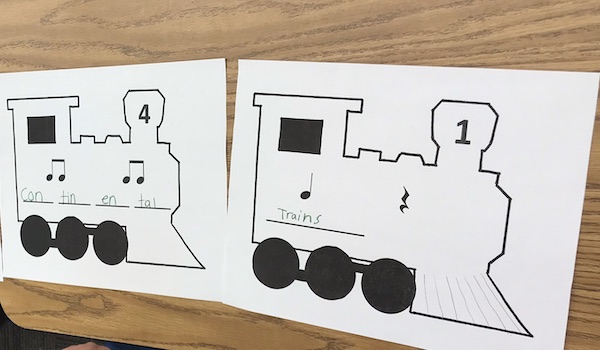
Lesson Summary
- Explore, create, and perform railroad sounds to a steady beat.
- Combine sounds to create a railroad soundscape.
- Create and play rhythms based on a Transcontinental Railroad theme.
Lesson Plan and Procedure
Lesson Key Facts
- Grade(s): 4, 5
- Subject(s): English Language Arts, Music, Social Studies
- Duration of lesson: Two sessions, 40 minutes each
- Author(s): Jennifer Purdy
Note: This lesson is one of a group of lessons created to teach about the Transcontinental Railroad through the arts. Titles of the lessons can be found in the additional resources section below.
Activities one and two are stand-alone activities that may be done in any order. Allow additional time for the “Applying to Literature” section of activity one and any variations on the activities if you choose to expand the lessons.
Warm-Up and Introduction
Show the illustrations as you read the book Iron Horses by Verla Kay. Read this metered text to a steady beat. Students keep a steady beat by quietly patting, finger-clapping, or tapping the steady beat as the words are read aloud. You may choose to occasionally stop and discuss the text, define unfamiliar words, help students make inferences about the content, and review facts about the Transcontinental Railroad. Challenge the students to play the beat all together, without speeding up or slowing down as you read.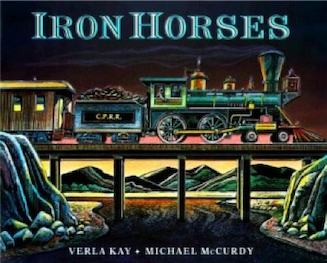
If you do not have access to the book, read just the following excerpt:
Piercing whistles,
Shrieking wheels.
Hot steam hissing,
High-pitched squeals.
Huffing, puffing,
Smoking stacks.
Screeching, stopping,
End of tracks.
“End of tracks” refers to the fact that even though there were railroads throughout the eastern part of the nation, they ended at the Mississippi River. Before the completion of the Transcontinental Railroad, getting to the western part of the continent meant a long journey traveling on foot or by stagecoach or wagon, or sailing on a ship around South America.
Activity 1: Iron Horses Soundscape
Sound Exploration
Students explore various ways to express the text through sound by using simple classroom instruments, found sounds, body percussion, or vocalizations. Found sounds are created using everyday objects. Some examples include tapping a pencil on a desk, dropping a book on the floor, scraping a chair across the floor, and crumpling a piece of paper. Body percussion includes snapping fingers, clapping hands, thumping chest, patting legs, and stomping feet.
Encourage the class to find many ways to express the sound of “piercing whistles.” Have each student choose his or her favorite way and perform it to the teacher’s continuous, steady eight-count beat played with sticks, a drum, clapping, etc. Students may choose to whistle for four beats and be silent for the other four beats, or whistle every two beats, or do some other variation.
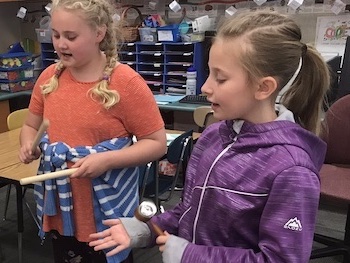 Have students imagine the sound of “shrieking wheels” on a train and find a way to express the sound using instruments, found sounds, body percussion, or vocalization. Students perform the sound to the teacher’s continuous eight-count beat.
Have students imagine the sound of “shrieking wheels” on a train and find a way to express the sound using instruments, found sounds, body percussion, or vocalization. Students perform the sound to the teacher’s continuous eight-count beat.
Continue to have students interpret each phrase of text by making sounds for “hot steam hissing, “high-pitched squeals,” and “huffing puffing, smoking stacks.” Enjoy exploring many sounds and rhythms.
Students who have not had a lot of practice performing sounds to a steady beat may need the teacher to model examples and ideas of ways to play sounds to a steady beat—how long to play each sound, how often, and when to not make sound within the eight beats.
Rhythm Layering
Divide the class into five groups and assign each group a sound: (1) piercing whistles, (2) shrieking wheels, (3) hot steam hissing, (4) high-pitched squeals, and (5) huffing, puffing, smoking stacks.
Each group will collaboratively determine how to make their assigned group sound and when they will play during the eight beats. Encourage students to make their group’s sound different than the other groups.
Some students may benefit from making a chart showing when to play and when to be silent. The students who created the chart below decided to shade in the boxes to show when to play, or use the symbol | to show how many sounds to make per beat.

Use this example for students to practice layering rhythms for a soundscape before creating their own.
Have each group practice repeating their sounds to a steady eight-count beat. When groups are ready, have one group start their sound and continue as each subsequent group joins in every eight beats. Students continue playing all the rhythms at the same time to the same steady beat. Challenge students to continue their train rhythms for 16 counts, 32 counts, and 64 counts without changing tempo or “getting off track.”
This video clip shows the first time this fourth-grade class practiced layering the parts as shown on the chart above. They began with huffing and puffing, then hot steam hissing, piercing whistles, shrieking wheels, and finally high-pitched squeals. They used only vocalization, instead of instruments.
The rhythm layering video can be found here.
Analyzing and Synthesizing
Teacher: Do our combined rhythms sound like a train? What imagery do the combined rhythms convey? Is there a sound we could change to something different? Is there a sound you would like to add? Is there something we need to improve? Do you want to change the rhythm of your group’s sound?
Make changes to the chart and the soundscape according to students’ suggestions and ideas; then repeat the soundscape. Other lines from the book that you may want to reflect in your class soundscape include the following: “thumping, bumping,” “ties and rails,” “clanging, banging,” and “spikes and nails.”
Refining and Evaluating
Trains start by moving very slowly until they gradually pick up speed. When it is time to stop, they slow down little by little. Steam engines typically come to a stop with a big blast of steam. Help students organize a way to start their rhythms together slowly, continue at tempo for a number of set beats, then slow down until they all end together in a hiss of steam.
Define and use some of these common musical terms: accelerando (gradually getting faster), andante (steady walking speed, about 80 to 100 beats per minute), allegro (quickly, about 120 to 160 beats per minute), ritardando (gradually slower), piano (quietly), mezzo forte (medium loud), forte (loud), crescendo (gradually getting louder), decrescendo (gradually getting softer).
Record and evaluate the soundscape performance according to criteria set by the teacher and/or the class.
Lesson Variation: Applying to Literature
Review the book Iron Horses and choose excerpts from the book that are most relevant to the students. Assigning students to choose the most important lines of text is a valuable language-arts activity.
Students perform their railroad rhythms to the same steady beat as the chosen text. The text may be read aloud by the teacher or by student readers who have practiced saying their parts to a steady beat. Adjust dynamics and performance ideas as needed so readers may be heard above the noise of the railroad rhythms.
One performance idea would be to begin with students performing the railroad rhythms, and then have students quietly play or show the steady beat through movement as the text is read. You may want different groups or individuals to read parts of the text. After the text is read, students resume performing the railroad rhythms at the same steady beat. End with a hiss of steam.
Lesson Variation: Ecosystems and Biomes
Students research the plants, animals, and landforms of the various ecosystems affected by the Transcontinental Railroad. Consider what the living things and environment would have sounded like in these diverse ecosystems and land areas before the Transcontinental Railroad was built across them. Have students create soundscapes reflecting the sounds they would have heard in each ecosystem before the advent of the railroad. Compare and contrast these soundscapes with the Iron Horses soundscape.
Activity 2: Word Rhythms
Students should have prior knowledge of the history of the Transcontinental Railroad. Some helpful resources are listed under “Additional Resources.”
Word Rhythms
On the board make a list of words relating to the Transcontinental Railroad. List them in columns by the number of syllables. An example is shown below.

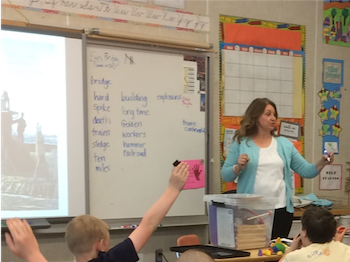 Ask for four volunteers to each tell his or her favorite word from the list. Show how to write each word, divided into syllables, onto a corresponding “Railroad Rhythm” word card (1, 2, 3, 4) . Put the cards into a sequence, and have all students practice saying and playing the rhythm of the words to a steady beat. Model various examples until students are able to create and play their own cards independently.
Ask for four volunteers to each tell his or her favorite word from the list. Show how to write each word, divided into syllables, onto a corresponding “Railroad Rhythm” word card (1, 2, 3, 4) . Put the cards into a sequence, and have all students practice saying and playing the rhythm of the words to a steady beat. Model various examples until students are able to create and play their own cards independently. 
Students get in small groups and make a train of cards using their favorite words from the list and four of the “Railroad Rhythm” word cards. Write each word on a card using one syllable per blank space. Students practice playing and saying their entire train to a steady beat using simple instruments or body percussion. They may want to rearrange their cards to find the most enjoyable and interesting rhythm.
Consider prosody. Some words such as “explosion” or “American” are not accented on the first syllable. Students who need to feel an accented first beat to stay together may find these words difficult to play.
Around the Track
Each group places their word-train cards in a continuous “track” with the other group’s cards. Each group stands in front of their section of the track and plays their rhythm as the rest of the class or the teacher keeps a quiet, steady beat. As soon as one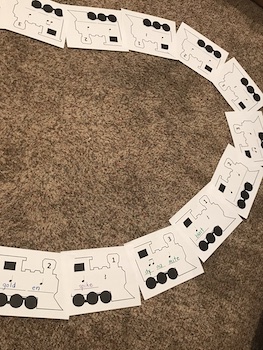 group finishes the last beat of their train rhythm, the following group begins their train rhythm on the next beat.
group finishes the last beat of their train rhythm, the following group begins their train rhythm on the next beat.
Lesson Variations
- Each group creates eight “Railroad Rhythm” word cards instead of four, making an even longer train when combined with all the other groups.
- Each group plays their rhythm two times before the next group plays.
- Students play their rhythms around the track to the beat of a railroad-themed instrumental accompaniment such as “Wabash Cannonball.” Repeat until the music ends.
Learning Objectives
- Conceptualize, generate, and organize artistic ideas and work, complete and refine musical works.
- Express meaning through the presentation of musical works.
- Analyze, interpret meaning, and evaluate artistic work and process.
- Synthesize and relate knowledge from personal and collaborative experience to make and receive art. Relate artistic ideas and works with societal, cultural, and historical context to deepen understanding.
- Make connections between the building of the Transcontinental Railroad and the history and culture of Utah.
- Read and understand key ideas and details in a text.
- Define vocabulary and determine meaning of phrases.
- Read with accuracy and fluency to a steady beat.
- Engage in collaborative discussions.
Utah State Board of Education Standards
This lesson can be used to meet standards in many grades and subject areas. We will highlight one grade’s standards to give an example of application.
Grade 4 Music
- Standard 4.M.CR.1: Improvise rhythmic and melodic patterns and musical ideas.
- Standard 4.M.CR.2: Explain the connection of musical ideas to specific purpose and context.
- Standard 4.M.CR.4: Select and demonstrate musical ideas to express intent while connecting to purpose and context.
- Standard 4.M.CR.5: Organize personal musical ideas using iconic notation or recordings to combine and/or sequence personal rhythmic and melodic ideas.
- Standard 4.M.CR.6: Evaluate and refine work; apply teacher-provided criteria and collaboratively developed guidelines and feedback; and present the final version of created music and describe connection to expressive intent.
- Standard 4.M.P.1: Explain how the selection of music to perform is influenced by personal interest, purpose, context and knowledge and skills.
- Standard 4.M.P.2: Explore the effects of various dynamic levels, tempos, and articulations.
- Standard 4.M.P.7: Perform and identify rhythm patterns in two-, and four-beat meters using body percussion, voice, and simple instruments.
- Standard 4.M.P.8: Respond with body percussion, voice, or simple instruments to visual representation of rhythm patterns.
- Standard 4.M.P.9: Respond to musical terms and markings for tempo.
- Standard 4.M.P.10: Demonstrate persistence and cooperation in refining performance pieces.
- Standard 4.M.P.11: Perform music with expression, technical accuracy and appropriate interpretation; watch and respond to the conductor to perform dynamics and start, stop, and stay together; and demonstrate performance decorum.
- Standard 4.M.R.1: Listen to and interact with a variety of contrasting music.
- Standard 4.M.R.5: Identify and describe elements that make contrasting music selections different from each other.
- Standard 4.M.CO.2: Draw upon interests, knowledge, and skills developed to inspire and inform the creation, performance, and appreciation of music, and deepen understanding of another content area through music.
- Standard 4.M.CO.3: Experience and explore music which connects us to history, culture, heritage, and community, and identify connections between a music genre and cultural or historical contexts.
Grade 4 Social Studies
- Standard 4.3.7: Explain how the creation of the Transcontinental Railroad and other transportation and communication networks changed Utah’s economy and led to greater economic interdependence.
Grade 4 English Language Arts
- Standard 4.R.5: Refer to details and evidence in a text when explaining what the text says explicitly and when drawing inferences from the text. (RL & RI)
- Standard 4.R.8: Determine the meaning of words, phrases, figurative language, academic and content-specific words within a text. (RL & RI)
- Standard 4.R.9: Determine or clarify the meaning of unknown and multiple-meaning words and phrases, choosing flexibly from a range of strategies. (RL & RI)
- Standard 4.R.10: Analyze and discuss the parts of literary text using terms such as chapter, scene, and stanza. (RL)
- Standard 4.R.6: Read a variety of text types, including those from diverse cultures to determine a theme or main idea and explain how it is supported by key details; summarize texts using textual evidence. (RL & RI)
- Standard 4.R.7: Explain events, procedures, ideas, or concepts in a historical, scientific, or technical text, including what happened and why, based on specific information in the text. (RI)
- Standard 4.R.4: Read grade-level text* with accuracy and fluency to support comprehension. (RL & RI)
- Standard 4.W.4: Conduct short research projects to build knowledge through investigation of different aspects of a topic.
- Standard 4.SL.1: Participate effectively in a range of conversations and collaborations, using age-appropriate vocabulary, on topics, texts, and issues.
Standard 4.SL.3: Include visual displays and/or media, when appropriate, to convey information, elaborate, and enhance engagement of presentations.
Equipment and Materials Needed
- Kay, Verla, and Michael McCurdy. Iron Horses New York: Putnam, 1999. (optional)
- Simple classroom instruments such as shakers, sticks, triangles, and so on. (optional)
- “Railroad Rhythm” word cards: one-syllable, two-syllable, three-syllable, and four-syllable
Additional Resources
- This is one of several lessons created to teach about the Transcontinental Railroad. The other lessons include the following:
- “Transcontinental Railroad—David Dynak” creating context
- “Transcontinental Railroad and the American West”: https://www.youtube.com/watch?v=0CdAzizWiyI
- “Wabash Cannonball” instrumental mp3 from the Utah State Board of Education Elementary Songbook
- Ten Mile Day: And the Building of the Transcontinental Railroad by Mary Ann Fraser
- The Transcontinental Railroad by John Perritano
- Coolies by Yin
- The Great Railroad Race: The Diary of Libby West, Utah Territory, 1868 (Dear America Series)
- Full Steam Ahead: The Race to Build a Transcontinental Railroad by Rhoda Blumberg
- Until the Last Spike: The Journal of Sean Sullivan, A Transcontinental Railroad Worker, Nebraska and Points West, 1867 (My Name is America Series)
Image References
Image 1: Jennifer Purdy.
Image 2: Iron Horses Image 5, www.alibris.com
Image 3 and video clip: Pieter Lingen.
Images 4-5: Jennifer Purdy.
Image 6: Pieter Lingen.
Image 7-8: Jennifer Purdy.

www.education.byu.edu/arts/lessons
 Download
Download